Unlock The Full Power Of Basic Selections In Photoshop
Let’s start by taking a look at how to add to an existing selection.
Download our tutorials as print-ready PDFs! Learning Photoshop has never been easier!
Adding To A Selection
To keep things simple, I have a fairly basic shape open in my Document Window: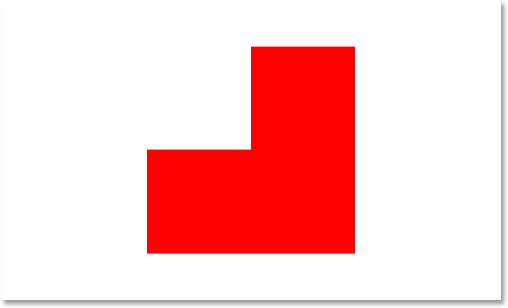
A basic shape in Photoshop.
I want to select this shape using the most common selection tool in all of Photoshop, the Rectangular Marquee Tool, so I’m going to grab it from my Tools palette:

Selecting the Rectangular Marquee Tool from Photoshop’s Tools palette.
I could also press M on my keyboard to quickly access it.
Now, let’s say all I know how to do is make a new selection with this tool. Hmm, this is going to be a bit tricky. I’ll start by dragging a selection around the bottom half of the shape. That should be easy enough:
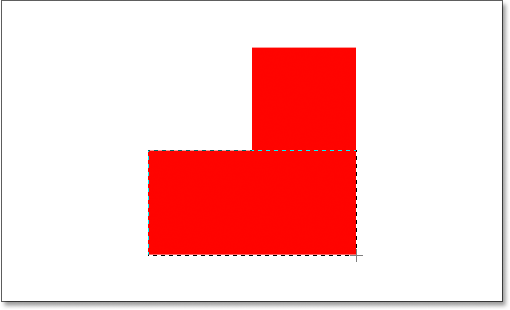
Dragging a selection around the bottom half of the shape.
There we go, looks good. The bottom half is selected. There’s still
that square part in the top right though, so I’ll just draw out another
selection, this time around that top square. Since I’m selecting a
square, I’m going to start from the top left corner of the shape and
then hold down my Shift key as I drag to constrain my selection to a perfect square:
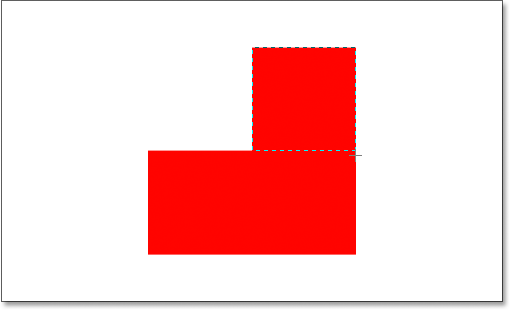
Selecting the square section in the top right of the shape.
There we go, the top of the shape is now selected. Except… wait a
minute. What happened to my original selection around the bottom part of
the shape? It’s gone!
Yep, it’s gone. I lost my original selection the moment I began dragging out my second selection, and that’s the default behavior of selections in Photoshop. Once you start dragging out another selection, your existing one disappears, which means there’s no way I can select this shape. It’s beyond the power of Photoshop to select something this complex. Oh well, thanks for joining us.
Okay, seriously, there most certainly is a way to select this shape, although we could never do it by dragging out a new selection each time, as we’ve already seen. What we need to be able to do is add a selection to our initial selection, and if this is something new to you, you’re about to wonder how you ever managed to work in Photoshop without knowing how to do this.
The Four Main Selection Options In The Options Bar
Before we go any further, with my Rectangular Marquee Tool selected, let’s take a look up in the Options Bar, specifically at four little icons on the left side of the Options Bar:
The four main selection option icons in the Options Bar.
They may look small, but each of those four little icons is very
powerful, because each one represents a different option for working
with our selections. The first one on the left, the one I’m clicking on
in the screenshot above, is the New Selection icon, and
it’s the one that’s selected by default when working in Photoshop. All
it does is create a new selection each time. If you never knew these
four options were there, this is the option you’ve always been using
without even knowing it.
The second icon directly beside it is the one we’re going to look at here, the Add To Selection icon:
The “Add To Selection” option in the Options Bar.
With this option selected, any selection I draw will be added to any selection(s) I’ve already made. Let’s see how this can help us select our shape.
First, I’m going to click back on the “New Selection” icon since I’m going to drag out my initial selection around the bottom half of the shape, the same as I did before:

Dragging a selection around the bottom half of the shape once again.
Now that I have my initial selection, I’m going to select that “Add
To Selection” option so that I can add another selection to this one.
Rather than selecting the option from the Options Bar though, I’m going
to use the quick keyboard shortcut, which is to simply hold down the Shift
key just before I start dragging out my selection. As soon as you press
the Shift key, you’ll see a small “plus sign” icon in the bottom right
corner of your cursor, which indicates that you’re about to add to the
existing selection:
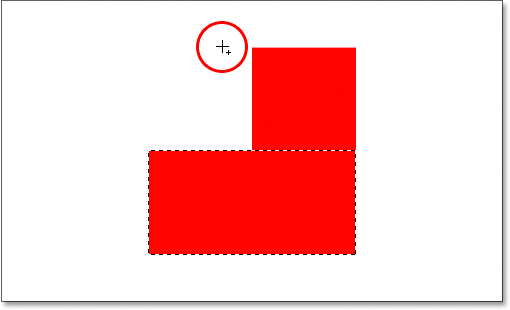
Hold down the “Shift” key to quickly access the
“Add To Selection” option. A small plus sign appears in the bottom right
corner of the cursor icon.
Let’s try selecting that top square part again. With my Shift key
held down, I’m going to drag out another selection around that square
section in the top right of the shape. This time, rather than trying to
select just the square, I’m going to select some of the area below the
square as well so that this second selection overlaps my intial one:
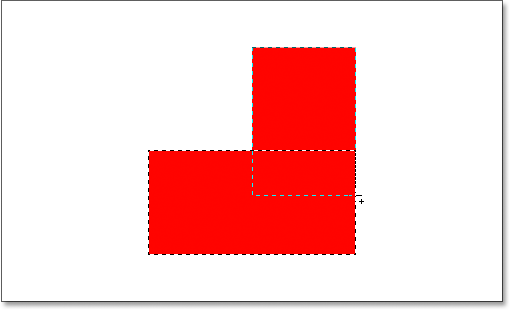
Dragging out the second selection, making both selections overlap.
One quick note… You don’t need to continue holding down the Shift key
the whole time you’re dragging out additional selections. All you need
to do is hold down Shift, then click your mouse to start dragging out
the selection, and once you’ve started dragging, you can safely release
the Shift key.
Now that I’ve dragged out my second selection that I’m adding to my intial selection, I’m going to release my mouse button, and look what happens:
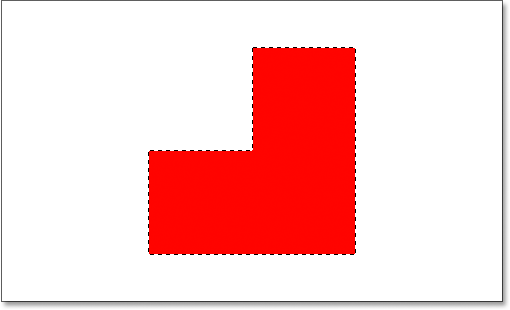
The second selection has now been added to the first.
Thanks to the “Add To Selection” option, which I accessed simply by
holding down my Shift key, my second selection has been added to my
initial selection, and my once impossible to select shape has now been
completely selected.
Let’s look at a common real world example to see how beneficial the “Add To Selection” option really is.
Using “Add To Selection” To Select Eyes
One of the most common questions I get is, “How do I select both eyes at once? I select one with the Lasso tool, but then when I go to select the other one, I lose the selection around the first eye”. Let’s look at this common problem, and how the “Add To Selection” option can solve it for us. I’ll use this photo here:
The original photo.
I’m going to quickly grab my Lasso tool from the Tools palette:

Selecting the Lasso tool from the Tools palette.
I could also press L on my keyboard to select it.
With the Lasso tool selected, I’m going to draw a selection around the left eye first:
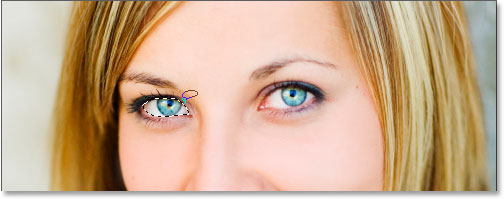
Selecting the left eye with the Lasso tool.
Now with the left eye selected (our left, her right), normally what
would happen is that if I tried to select the eye on the right, I’d lose
my selection around her left eye. But with the “Add To Selection”
option, that’s not the case. I’m going to hold down my Shift
key once again to quickly access that “Add To Selection” option, which
gives me that small plus sign in the bottom right corner of my mouse
cursor, and then with my Shift key down, I’m going to select her right
eye. Again, I don’t need to hold the Shift key down the entire time.
Once I’ve started my selection, I can release it. I’ll go ahead now and
select her other eye:

Selecting the other eye using the “Add To Selection” option. It’s that easy.
And there we go, both eyes are now selected thanks to the “Add To Selection” option.
In the first example where we used “Add To Selection” to select all of the shape, I overlapped the selections to create one main selection. In this example with the eyes, my selections appear to be completely separate from each other, yet Photoshop still treats them as the same selection. I could select her hair, her eyebrows, her lips, and her teeth all separately as well, and as long as I’m using the “Add To Selection” option each time, Photoshop will treat them all as one selection.
So that’s our look at the “Add To Selection” option. Now let’s look at the “Subtract From Selection” option.
The “Subtract From Selection” Option
Before we see how the “Subtract From Selection” option works, let’s first see where to access it. For that, we go back up to the Options Bar for another look at those four little icons. The “Subtract From Selection” icon is the third one from the left:
The “Subtract From Selection” icon in the Options Bar.
Now that we know where it is, let’s see how to use it.
Sometimes when you’re trying to select a complex shape, it’s easier to select the entire shape first and then subtract from your selection. Let’s use our shape again from the beginning of this tutorial:
 The first time I selected this shape, I selected the bottom half
first and then used the “Add To Selection” option to grab the remaining
square section in the top right. This time, to show you how the
“Subtract From Selection” option works, I’m going to start by selecting
the entire shape. I’m going to use the Rectangular Marquee Tool once
again, and I’ll just drag a quick selection around the whole thing:
The first time I selected this shape, I selected the bottom half
first and then used the “Add To Selection” option to grab the remaining
square section in the top right. This time, to show you how the
“Subtract From Selection” option works, I’m going to start by selecting
the entire shape. I’m going to use the Rectangular Marquee Tool once
again, and I’ll just drag a quick selection around the whole thing:
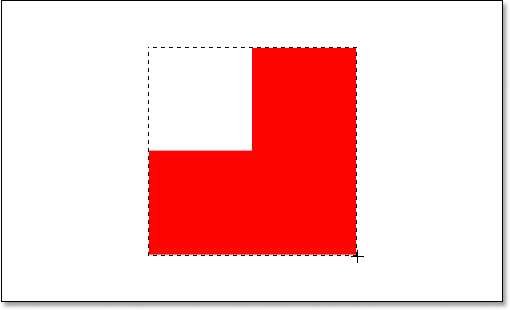
Selecting the entire shape with the Rectangular Marquee Tool.
Looks good, except for one obvious problem. By dragging a selection
around the entire shape, I’ve also selected that empty square section in
the top left. Thanks to the “Subtract From Selection” option though, I
can easily fix that.
Just as we saw with the “Add To Selection” option, the “Subtract From Selection” option has a handy keyboard shortcut so we don’t have to keep selecting it from the Options Bar every time we need it. All you need to do is hold down the Alt (Win) / Option (Mac) key, which places a little “minus sign” in the bottom right corner of your mouse cursor:

Hold down the Alt key on Windows or the Option key on Mac to quickly access the “Subtract From Selection” option.
Using my Rectangular Marquee Tool and the “Subtract From Selection”
option, I’m going to select that empty square section in the top left of
the shape to remove it from my existing selection. Holding down my
Alt/Option key, I’m going to start my selection from just outside the
top left corner of my existing selection, and then I’m going to drag my
mouse down and to the right until I’ve selected the entire empty area
that I want to remove:
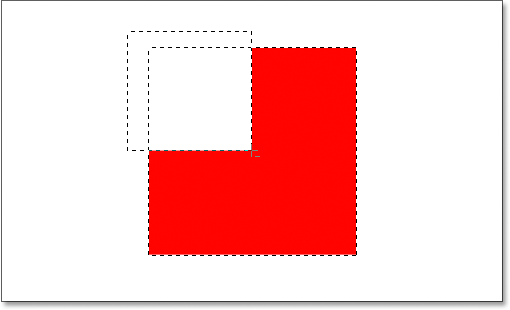
Selecting the area I want to remove from my existing selection.
As with the “Add To Selection” option, you don’t need to hold down
the Alt/Option key the entire time you’re dragging the selection. All
you need to do is hold it down just before you start dragging, and then
as soon as you’ve clicked your mouse button down, you can let go of the
Alt/Option key.
Now that I’ve selected the part of the original selection that I want to remove, all I need to do is release my mouse button, and presto:
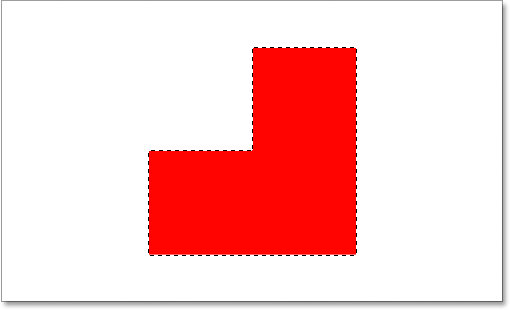
The empty square section in the top left has been removed from the original selection.
That empty section in the top left has now been removed from the
original selection, leaving only my shape selected, thanks to the
“Subtract From Selection” option.
Let’s round out our look at the full power of basic selections in Photoshop with the final option, “Intersect With Selection”.
The “Intersect With Selection” Option
We’ve seen how to add to an existing selection. We’ve seen how to subtract an area from a selection. Now let’s look at the final option, “Intersect With Selection”. First, let’s go back up to the Options Bar to see where we can find the “Intersect With Selection” option, and then we’ll see how to use it. Again looking at our four little yet powerful icons, the “Intersect With Selection” icon is the one on the right:
The “Intersect With Selection” icon in the Options Bar.
Just as with the “Add To Selection” and “Subtract From Selection”
options, this one also has a handy keyboard shortcut so you don’t have
to keep going up to the Options Bar to access it. The keyboard shortcut
is Shift+Alt (Win) / Shift+Option (Mac). So just as a quick keyboard shortcut summary:
- Shift = Add To Selection
- Alt (Win) / Option (Mac) = Subtract From Selection
- Shift+Alt (Win) / Shift+Option (Mac) = Intersect With Selection
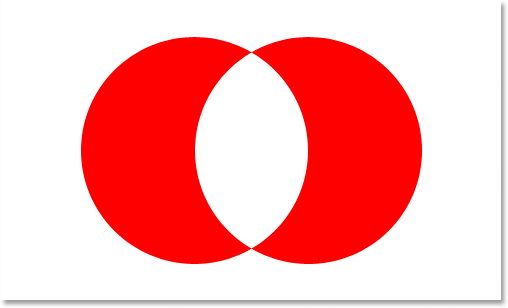 Here we have two red crescent shapes, one on the left and one on the
right, with an empty white area in between them. Let’s say we needed to
select that empty white area. We could try to use the Lasso
tool, but unless you’re talented at drawing perfect circles, good luck.
We could use the Magic Wand tool here, since the area we want to select
is solid white, but what if it wasn’t? What if it was a full color photo
and we needed to create a selection in that shape? The Magic Wand tool
would probably be useless to us in that case. So what to do?
Here we have two red crescent shapes, one on the left and one on the
right, with an empty white area in between them. Let’s say we needed to
select that empty white area. We could try to use the Lasso
tool, but unless you’re talented at drawing perfect circles, good luck.
We could use the Magic Wand tool here, since the area we want to select
is solid white, but what if it wasn’t? What if it was a full color photo
and we needed to create a selection in that shape? The Magic Wand tool
would probably be useless to us in that case. So what to do?
Well, Photoshop has a basic selection tool that’s built for selecting round objects, the Elliptical Marquee Tool, so let’s try that. First, I’ll select it from the Tools palette:

Selecting the Elliptical Marquee Tool from the Tools palette.
Then, with my Elliptical Marquee Tool selected, I’m going to draw a
circular selection around that first shape on the left. As I drag, I’m
going to hold down my Shift key to constrain my selection to a perfect circle:
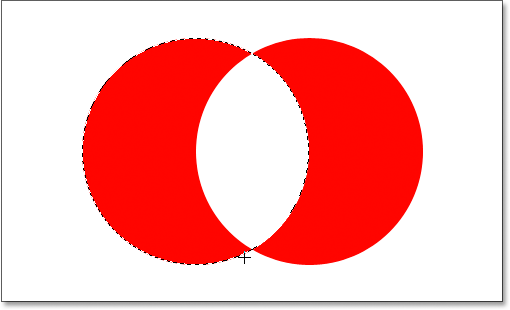
Selecting the crescent shape on the left with the
Elliptical Marquee Tool. Hold “Shift” to constrain the selection to a
perfect circle.
Now I have that left shape selected, but I also have the white area in the middle selected, and my goal is to select only
that white area in the middle. Let’s see, I could try the “Add To
Selection” option while dragging out another selection around the shape
on the right:
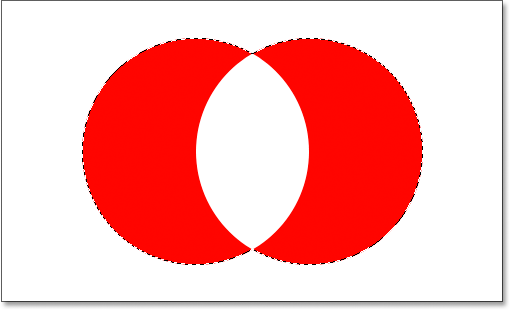
Dragging a selection around the shape on the right using the “Add To Selection” option.
Nope, that didn’t work. All it did was put a selection around both
shapes. Maybe I could try dragging a selection around the shape on the
right using the “Subtract From Selection” option:
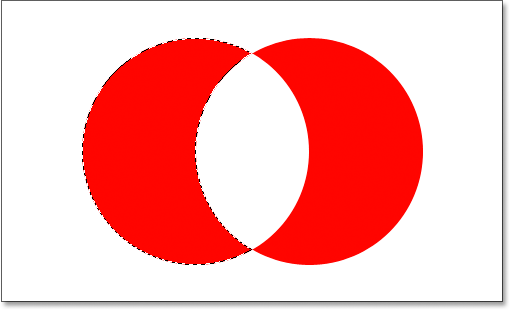
Dragging a selection around the shape on the right using the “Subtract From Selection” option.
Nope, that didn’t work either. The “Subtract From Selection” option
was able to give me a perfect selection around the shape on the left,
but that’s still not what I wanted. Time to try the final option, Intersect With Selection.
The way “Intersect With Selection” works is that it looks at the initial selection you made and the selection you’re currently dragging out, and keeps only the area where both selections overlap, or “intersect”. So if, for example, I was to drag a circular selection around the shape on the left, and then drag another circular selection around the shape on the right using the “Intersect With Selection” option, what I’d end up with is a selection around only that white empty space between them where the two selections would overlap. Which, come to think of it, is exactly what I want!
Let’s try it out. With my shape on the left already selected, and using the Elliptical Marquee Tool, I’m going to use the keyboard shortcut Shift+Alt (Win) / Shift+Option (Mac) and drag out a second selection around the shape on the right, causing the area in between the shapes to overlap. If you look in the bottom right corner of the mouse cursor (circled in red below), you can see a small “x”, indicating that I’m using the “Intersect With Selection” option:
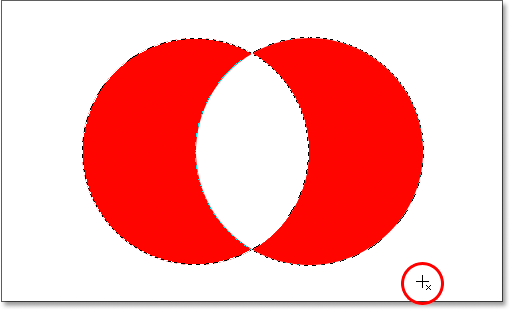
Dragging a selection around the shape on the right using the “Intersect With Selection” option.
As with the previous two options we looked at, once you’ve begun
dragging out your selection, there’s no need to continue holding down
the Shift and Alt/Option keys.
Using “Intersect With Selection”, I now have the shape on the right also selected, and we can see that both selections overlap around the white space between them, which is the area I want to select. All I have to do now is release my mouse button, and Photoshop will select only that white area in the middle where my selections intersected:
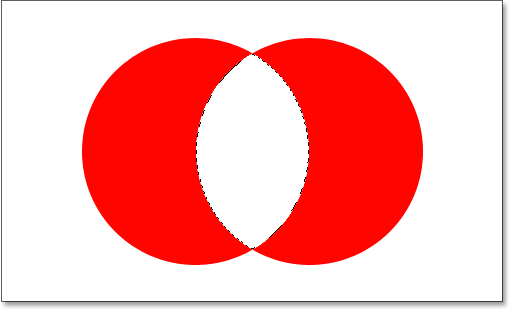
The white area in between the two shapes is easily selected with the “Intersect With Selection” option.
And there we have it. Using that “Intersect With Selection” option, selecting the white area between the two shapes was easy.
We’re now armed with the full power of basic selections in Photoshop. Not only can we make new selections, we can add to existing selections, subtract areas from existing selections, and intersect selections to easily grab the area where they overlap. We’ve arrived at our full potential. The world is within our grasp. The sky’s the limit. The future’s so bright, I gotta wear shades. The….. okay, I’ll stop now.
Comments
Post a Comment